Pharma Social Media Profiles: An Analysis
Shrujitha Ramanujam outlines Unmetric's analysis of pharma's social media activity on LinkedIn and Facebook.
In 2018, there were more than 3 billion social media users. This gives brands the opportunity to converse and engage with a larger audience base. Over the years, pharma brands have made their presence known on several social networks such as LinkedIn, Facebook, Instagram, Youtube, and Pinterest. We noticed that pharma brands were posting similar content on their Facebook and LinkedIn pages. Was this a conscious strategy to increase engagement? To get a better understanding, we compared the social profiles of pharma brands on LinkedIn and Facebook.
We looked at 16 pharmaceutical brands' LinkedIn and Facebook activity. The brands analyzed were Abbott, AbbVie, Allergan, AstraZeneca, Bayer, Boehringer Ingelheim, Bristol-Myers Squibb, Eli Lilly & Company, GSK, Johnson & Johnson, Merck, Novartis, Novo Nordisk, Pfizer, Roche and, Sanofi. Facebook and LinkedIn posts were analyzed from September 1, 2018 to February 28, 2019.
Using Unmetric Analyze to analyze their social media profiles, we found that pharma brands post more on LinkedIn despite higher interactions on Facebook. Pharma brands tended to post more on LinkedIn than Facebook with 64% of the overall posts by these brands coming from LinkedIn. Despite this, LinkedIn fell short on the number of interactions when compared with Facebook. (Interactions were calculated as the sum of likes, comments, and shares for Facebook. In LinkedIn, the interactions were calculated as the sum of likes and comments [shares data is not available for LinkedIn]).
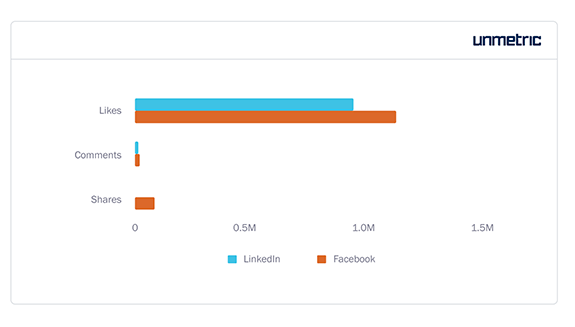
Pharma brands have always had to be extra-careful while publishing on social because of the regulations they must comply with. Their social media presence serves more to build customer trust and to raise audience awareness to indirectly increase sales. LinkedIn is now the place for brands to drive brand awareness while educating the public on their products and services. Despite the lower interactions on LinkedIn, pharma brands still flock to this social platform.
Another thing to keep in mind is that pharma brands also use social to publicize career opportunities. 7% of all posts by these brands on LinkedIn were regarding career opportunities.
Pfizer and Merck published the most content
We dug a little deeper to see which brands published the most content on social.
Merck published the most content on LinkedIn, followed by AstraZeneca. Merck posted 14% of all the content by these 16 brands on LinkedIn.
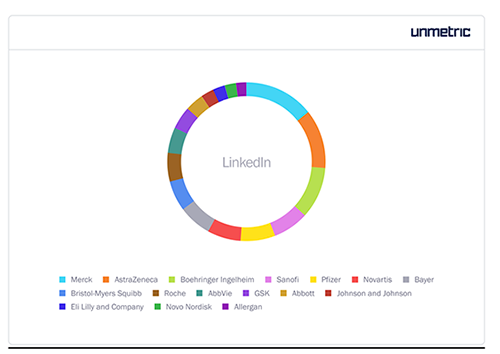
Pfizer published 15% of all content on Facebook by these 16 pharma brands, closely followed by Johnson & Johnson.
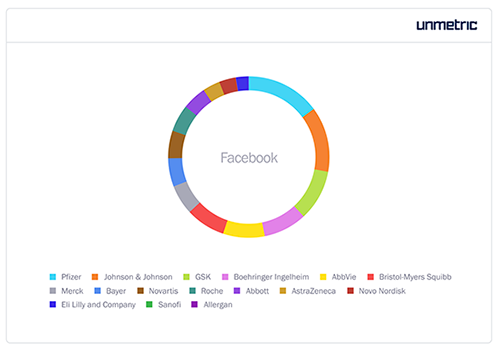
Overall
Pfizer had the most content published on both platforms together, closely followed by Johnson & Johnson.

Pharma brands used images more often than videos or links
On LinkedIn, the brands that posted a large number of posts were more likely to post images than links or videos. Overall, pharma brands published twice as many posts with images than links. Brands that published fewer posts such as Novartis and Johnson & Johnson predominantly used links.
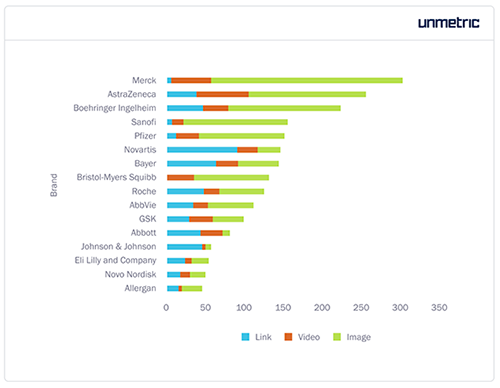
40% of all posts on Facebook had images. 34% contained videos. But 86% of Johnson & Johnson posts included images.
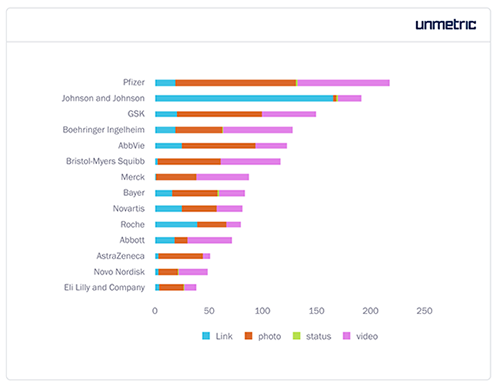
17% of all content on Facebook and LinkedIn was the same
We looked at the type of posts as well as the volume of posts and while analyzing that data, we found that brands were publishing the same content on Facebook and LinkedIn. Digging deeper, we wanted to see exactly how much of this content was the same.
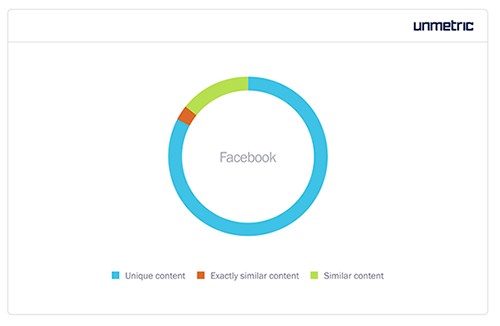
The 16 pharma brands published 3,581 posts on both social platforms. 3% of those posts were exactly the same on LinkedIn and on Facebook. 14% of the posts by these brands on Facebook and LinkedIn were found to be similar to each other, but with a few minor differences. For example, the two posts by AbbVie convey the same message to their followers. The only difference is the slight change in the wording used.
What kind of content?
Use of hashtags
Brands used hashtags more frequently on LinkedIn than on Facebook. 61% of all posts on LinkedIn by these brands had at least one hashtag, whereas only 37% of posts on Facebook contained hashtags. Below are examples of where the same content is being published by Novartis with the only difference being the use of hashtags on their LinkedIn post.
http://www.facebook.com/139511646066086/posts/337448750335524
https://www.linkedin.com/feed/update/urn:li:activity:6451300438821126144/
Use of emojis
Pharma brands tend to use emojis on their posts on Facebook but refrained from doing so on LinkedIn.
http://www.facebook.com/314499212242/posts/10156827448017243
http://www.facebook.com/123311187737843/posts/2046071762128433
http://www.facebook.com/314499212242/posts/10156953337807243
Length
The content on Facebook is much crisper and to the point, whereas on LinkedIn brands chose to elaborate more.
Word Cloud
We looked at the most common words brands used on their posts to better understand what was trying to be conveyed through these posts. The three most common words used on both platforms are “learn”, “people” and “patients.” This goes to show that pharma brands use these social platforms to primarily educate their audience on their latest innovations and their services and products.
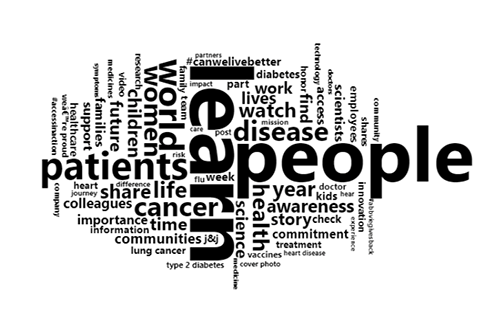

Conclusion
With the massive traction brands can gain on social, pharma brands can no longer shy away from social media. It helps to engage with their audience and build customer trust. Unlike other mainstream industries, pharma stresses more on educating their audience on their services and products. It also uses social media to update followers with their latest partnerships and innovations. With this in mind, LinkedIn does serve pharma its purpose more so than other social platforms. But to some brands, such as Johnson & Johnson, Facebook presence is more important based on what they are using social media for.
Shrujitha Ramanujam, social media data journalist, Unmetric.
The Misinformation Maze: Navigating Public Health in the Digital Age
March 11th 2025Jennifer Butler, chief commercial officer of Pleio, discusses misinformation's threat to public health, where patients are turning for trustworthy health information, the industry's pivot to peer-to-patient strategies to educate patients, and more.
Navigating Distrust: Pharma in the Age of Social Media
February 18th 2025Ian Baer, Founder and CEO of Sooth, discusses how the growing distrust in social media will impact industry marketing strategies and the relationships between pharmaceutical companies and the patients they aim to serve. He also explains dark social, how to combat misinformation, closing the trust gap, and more.
The Misinformation Maze: Navigating Public Health in the Digital Age
March 11th 2025Jennifer Butler, chief commercial officer of Pleio, discusses misinformation's threat to public health, where patients are turning for trustworthy health information, the industry's pivot to peer-to-patient strategies to educate patients, and more.
Navigating Distrust: Pharma in the Age of Social Media
February 18th 2025Ian Baer, Founder and CEO of Sooth, discusses how the growing distrust in social media will impact industry marketing strategies and the relationships between pharmaceutical companies and the patients they aim to serve. He also explains dark social, how to combat misinformation, closing the trust gap, and more.
2 Commerce Drive
Cranbury, NJ 08512
All rights reserved.